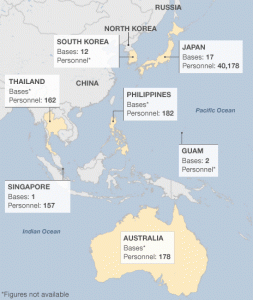The Obama administration is continuing its strategic pivot to Asia-Pacific and now trying to cultivate renewed relationships with countries in a bid to further expand the amount of US military bases throughout the region.
Much of this means rebuilding and refurbishing former US bases that were abandoned since WWII or since the Vietnam War. Administration officials have been in intense talks with the Thai government over using airfields and naval ports and Secretary of Defense Leon Panetta recently visited Vietnam to visit the naval and air base at Cam Ranh Bay.
The Obama administration has been ramping up the pressure on China with an increasingly antagonistic foreign policy. The so-called ‘Asia pivot’ is an aggressive policy that involves surging American military presence throughout the region – in the Philippines, Japan, Australia, Guam, South Korea, Singapore, etc. – in an unprovoked scheme to contain rising Chinese economic and military influence.
The US has also been refurbishing long-abandoned World War II bases scattered across the Pacific for potential use in the event of a major conflict with China. Last month, US Marines rebuilt and restored the 8,000-foot runway at the abandoned North Field air base on the island of Tinian and engaged in a military exercise with nearby US forces based in Guam. The Tinian airbase is where the B-29s that dropped atomic bombs on Hiroshima and Nagasaki took off from in 1945.
The idea is to have enough U.S. bases peppered throughout the region so that China would be too surrounded to safely attack. “Doing so would make it more difficult for China to wipe out entire squadrons sitting on the ground with surprise attacks from its long range ballistic missiles,” according to reports from Military.com.
This bellicose posture has increased tensions between the U.S. and China and between China and its weaker neighbors, like the Philippines. A recent report from the Center for Strategic International Studies predicted that next year “could see a shift in Chinese foreign policy based on the new leadership’s judgment that it must respond to a U.S. strategy that seeks to prevent China’s reemergence as a great power.”
“Signs of a potential harsh reaction are already detectable,” the report said. “The US Asia pivot has triggered an outpouring of anti-American sentiment in China that will increase pressure on China’s incoming leadership to stand up to the United States. Nationalistic voices are calling for military countermeasures to the bolstering of America’s military posture in the region and the new US defense strategic guidelines.”



